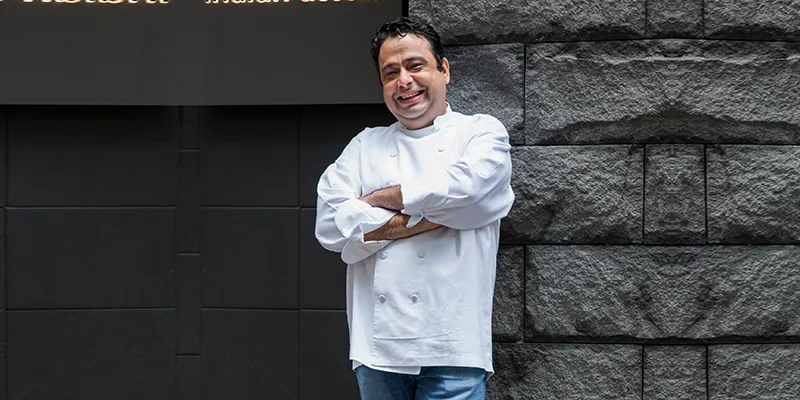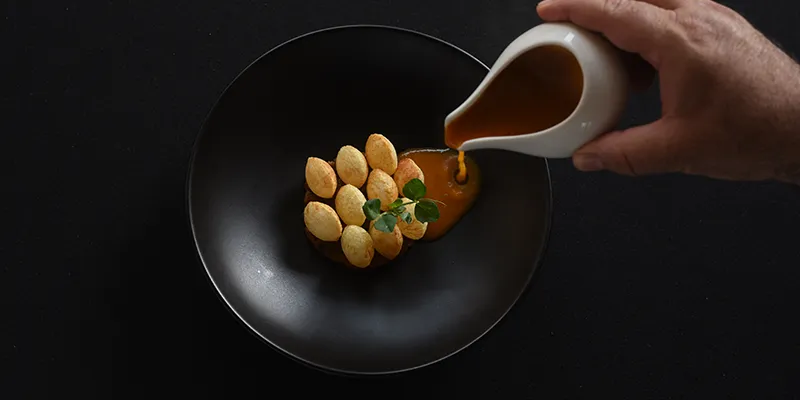Street food culture: Chef Manish Mehrotra dishes up new strategies amid the pandemic
Chef Manish Mehrotra has introduced an experimental Tasting Menu in order to entice food lovers back to his restaurant. He talks about the safety norms that are in place in restaurants, his new menu and future plans
Indian Accent, a progressive Indian restaurant ranked 60th in The World's 50 Best Restaurants in 2020, and 13th in Asia’s 50 Best Restaurants in March 2020. Behind these milestones, is Chef Manish Mehrotra, for whom, 2020 began on a great note.

Manish Mehrotra
But the pandemic that caught the world in its grip soon placed the restaurant industry on an unprecedented hiatus. Numerous realignments and experiments later, the Indian F&B industry is still grappling and making amends to the losses incurred from being shut for months altogether. Indian Accent wasn’t exempt from the aftermath either. Their London outpost which opened in 2017 has shut doors permanently.
Pandemic woes
Manish explains, "As soon as the pandemic was declared one of the first things that happened was restaurants were shut and people stopped going out to eat. People were scared to venture out as eating out is generally deemed unhealthy. Hence, the worst casualty of the pandemic has been the restaurant industry," says Manish who is an IHM Bombay alumni.
In order to entice food lovers back to their much-loved dining space Mehrotra’s ingenious idea has been to introduce a chaat menu, as an experimental Tasting Menu available only for lunch at their restaurant in Delhi.
The chaat menu

The menu has hit the right spot for chaat-deprived patrons as it has an evocative mix of snacks available as street food in different parts of India.
Explaining the idea behind this eclectic menu, Manish says, "Chaat in India has always been a controversial topic, where cities famous for their ‘chatpata’ offerings vie for the coveted spot. The pandemic has rendered street foot joints and hawkers as one of its worst ‘small business’ casualties.
Today, stopping at the roadside chaat guy to savour our favourite bhelpuri, golgappas, and other chaat items - is a strict no-no. So, after much deliberation and research, we compiled this menu which has chaat from places such as Lucknow, Banaras, and Old Delhi but not without Indian Accent’s signature spin. So, a moonglet (a vegetarian pancake of sorts made with lentils) is served with a dash of gari, but the taste and charm of Old Delhi are kept intact with every mouthful.”

The moonglet does shine on the table as you find not only the ‘gari spin’ but also other elements which remind you of Old Delhi such as the grated radish, seen on the moonglet as a garnish, or the sweet chutney without which purani dilli ka khana is incomplete. Banarasi Tamatar Chaat, Rainbow Quinoa Bhel, and Lucknow White Pea Tikkis are among the many delicacies which one can savour in this menu.
Safety standards
While the industry is limping back towards normalcy, restaurants are going all out in enforcing measures to make the dining-out experience safe for customers.
"Besides the usual sanitising protocols and widely distanced tables, we ensure additional safe practices such as minimal touching of the dinnerware at our end.”

The impact of the lockdown on the Indian restaurant industry has ongoing repercussions with large scale unemployment and no government aid or relief to the largely unorganised industry.
In the wake of the immense losses faced by them, controlling costs is one of the measures with which the industry is trying to help itself.
“We have introduced stringent measures to control costs like no overtime to staff which also means the management, as well as the patrons, have to follow and respect the restaurant timings. Our staff follows the rosters diligently. Other measures, like prior booking to estimating the guest count, and optimising the electricity usage during non-operational hours are also being taken,” Manish explains.
Tasting menu
Even as people across the world developed a new-found interest in replicating restaurant-style dishes at home, Manish says, “Since we opened in October after not being operational for so many months, we chose to begin with a small menu to test the waters, both, for our customers and our staff, to make them fall back into a routine after being out of practice for long. Business may not be as usual for us in the current scenario but we deem ourselves lucky to have many old patrons having faith in us to step out and dine safely with us."
The days ahead
But all in the industry is not hunky-dory, says Manish. “In our country where eating out is still considered a luxury, the restaurant industry is also one of the major employers. The brunt of shutting down of restaurants was passed on to the migrant labourers and daily wage-earners as they were left jobless.”
While many may have moved out of the industry to make a living in other sectors, one also observes a deluge of cloud kitchens as well as experimental concepts taking birth. It will be interesting to see how the restaurant industry evolves in the time to come. All eyes, however, would be on chefs like Manish who continue to place Indian food on the world map.
Edited by Asha Chowdary
(Disclaimer: The views and opinions expressed in this article are those of the author and do not necessarily reflect the views of YourStory.)









